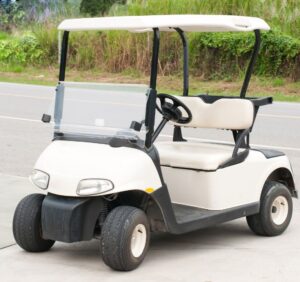
Gas golf carts are a popular choice for navigating the green, offering convenience and flexibility for golfers and enthusiasts alike. While these vehicles are designed primarily for utility and leisure, there are times when you might want a little extra speed to zip around the course or complete tasks more efficiently. In this guide, we’ll explore: how to make a gas golf cart faster, why my gas golf cart going so slow, and Which is faster gas or electric golf cart.
Read also: How to Measure for Golf Clubs?
how to make a gas golf cart faster
There are ways to modify a gas golf cart for more speed, but it’s important to be aware of the drawbacks before making any changes. Here’s a breakdown of some methods and the considerations:
Increasing Engine Performance:
-
Remove the Governor: This is the most common method, but also the riskiest. The governor limits the engine’s RPMs and thus the top speed. Removing it can lead to engine wear, overheating, and decreased lifespan.
-
Upgrade the Air Filter: A high-flow air filter allows more air into the engine for better combustion and potentially a slight speed increase. It’s a relatively simple and safe modification.
-
Install a Performance Kit: These kits may include parts like a new carburetor, camshaft, or exhaust system. They can be expensive and require mechanical expertise to install. Improper installation can cause engine damage.
Other modifications:
-
Larger Tires: Bigger tires will cover more distance with each rotation, effectively increasing top speed. However, this can affect handling and strain the engine if not chosen correctly.
-
Lift Kit: While not directly increasing speed, a lift kit allows for larger tires which can contribute to a higher top speed. Lift kits can also affect handling and stability.
Important Considerations:
-
Safety: Golf carts are not designed for high speeds. Making modifications can increase the risk of accidents, especially on uneven terrain.
-
Warranty: Modifications typically void the manufacturer’s warranty.
-
Legality: In some areas, laws may restrict golf carts’ speed on public roads. Check your local regulations.
Alternatives:
-
If you need a faster vehicle, consider a different type of utility task vehicle (UTV) designed for higher speeds and off-road use.
-
Some golf cart manufacturers offer high-performance models designed for increased speed while maintaining safety features.
Read also: Golf course
How fast is a gas golf cart?

The average top speed of a gas golf cart without modifications is between 12 and 14 miles per hour (19-23 kilometers per hour). This is similar to the speed of electric golf carts.
It’s important to note that this is just a general range, and the actual speed can vary depending on several factors, such as:
- Specific model and year of the cart: Newer models or those designed for increased speed may be slightly faster.
- Terrain: Going uphill or on uneven terrain will slow down the cart.
- Weight of passengers and cargo: More weight will decrease the top speed.
- Tire size: Larger tires can increase the top speed slightly.
It’s important to remember that modifying a golf cart for higher speeds can be dangerous and is not recommended. Always prioritize safety and follow the manufacturer’s recommendations for your specific cart.
Read also: How Should Golf Pants Fit?
Why is my gas golf cart going so slow?
There could be several reasons why your gas golf cart is sluggish. Here are some common culprits:
Low Battery Voltage
Even though it’s a gas-powered cart, the battery still plays a crucial role. A weak battery might not deliver enough power to the ignition system, leading to sluggish performance. Check the battery voltage with a voltmeter and ensure it meets the manufacturer’s specifications.
Air Filter Clogged
A dirty air filter restricts airflow to the engine, hindering proper combustion and reducing power output. This can cause the cart to run slower than usual. Check your air filter and replace it if clogged.
Fuel Delivery Issues
Problems with the fuel system can also cause sluggishness. Here are some possibilities:
- Dirty Carburetor: A dirty carburetor can prevent the proper mixture of air and fuel, leading to power loss.
- Clogged Fuel Filter: A clogged fuel filter restricts fuel flow to the engine, causing hesitation and slow acceleration.
- Faulty Fuel Pump: If the fuel pump is weak or failing, it might not deliver fuel efficiently, affecting engine performance.
Governor Issues
The governor on a gas golf cart regulates the engine RPMs and limits the top speed. If the governor malfunctions, it could restrict engine power even at lower speeds.
Drive System Problems
- Belt Wear: The drive belt transfers power from the engine to the wheels. A worn or damaged belt can cause slippage and reduce power delivery.
- Clutch Problems: A faulty clutch can cause hesitation or jerky acceleration, making the cart feel sluggish.
Other Possibilities
- Spark Plug Issues: Faulty spark plugs can cause weak ignition and incomplete combustion, leading to power loss.
- Exhaust System Blockage: A clogged exhaust system can restrict exhaust flow and reduce engine efficiency.
Recommendations
- Consult your golf cart’s user manual for specific maintenance recommendations and troubleshooting steps.
- If you’re not comfortable troubleshooting the problem yourself, it’s best to take your cart to a qualified golf cart mechanic for diagnosis and repair.
Which is faster gas or electric golf cart?

Contrary to a common misconception, electric golf carts can be faster than gas golf carts in several aspects:
- Acceleration: Electric motors deliver near-instantaneous torque, giving electric carts a quicker jump from a standstill compared to gas carts.
- Top speed: Many modern electric carts, especially those with 48-volt systems, boast higher top speeds than their gas counterparts. Out of the box, electric carts often reach speeds of 14-18 mph (23-29 km/h), while gas carts typically range from 12-14 mph (19-23 km/h). Some electric carts can even be modified for even higher speeds, though safety concerns and legal restrictions should be considered.
However, it’s important to note that gas carts might have an advantage in:
- Sustained speed on long stretches: Gas carts generally have a larger fuel capacity, allowing them to travel farther before needing to refuel compared to the limited range of electric carts on a single charge.
- Power on inclines: Gas engines might perform better on steeper hills due to their ability to generate more power under load compared to electric motors.
Overall, the “faster” option depends on what aspect of speed you prioritize. If you value quick acceleration and a higher potential top speed, electric carts are generally the better choice. However, if you need a cart for longer trips or tackling steeper inclines, gas might be a better fit.
Read also: How Tall is a Golf Cart with a Roof?
Understanding the Mechanics of a Gas Golf Cart
Before diving into methods for increasing speed, it’s essential to understand how gas golf carts operate. Unlike electric models, which rely on batteries for power, gas carts are equipped with internal combustion engines similar to those found in automobiles. These engines generate the necessary torque to drive the vehicle forward, with the speed controlled by a governor mechanism.
Factors Limiting Speed
Several factors can influence the speed capabilities of a gas golf cart. The engine’s power and performance play a significant role, as do external factors like the cart’s weight and payload. Additionally, the size and type of tires can affect traction and overall speed, especially on varied terrain.
Safety Considerations
While the allure of increased speed is undeniable, it’s crucial to prioritize safety when modifying a gas golf cart. Altering the vehicle’s speed can impact its stability and handling, potentially increasing the risk of accidents or loss of control. Before making any modifications, consider the potential consequences and take appropriate precautions.
Methods to Increase Speed
There are several approaches to boosting the speed of a gas golf cart, ranging from simple adjustments to more extensive modifications. One common method is to upgrade the engine with performance parts, such as high-flow carburetors or aftermarket exhaust systems. These enhancements can improve horsepower and torque, resulting in faster acceleration and higher top speeds.
Another option is to adjust the governor mechanism, which regulates the engine’s RPM (revolutions per minute) and limits its maximum speed. By tweaking this setting or installing a governor bypass kit, you can unlock additional speed potential while still maintaining control over the vehicle.
Choosing the Right Modifications
Choosing the right modifications for your gas golf cart is crucial to achieving the desired balance of speed, performance, and reliability. With numerous options available, it’s essential to consider several factors to ensure that your chosen upgrades align with your goals and budget. Here’s a closer look at what to consider when selecting modifications for your gas golf cart:
Budget Considerations
- Cost of Modifications: Evaluate the cost of each potential modification, including parts, labor, and any additional components needed for installation.
- Overall Budget: Determine your total budget for modifications, taking into account other expenses such as maintenance, accessories, and future upgrades.
- Cost vs. Performance: Assess the cost-effectiveness of each modification in terms of the performance gains it offers compared to its price.
Performance Expectations
- Desired Speed Increase: Define your desired level of speed enhancement, whether you’re aiming for a modest improvement or significant gains in acceleration and top speed.
- Performance vs. Reliability: Consider the trade-off between performance and reliability when selecting modifications, as certain upgrades may impact the longevity and durability of your cart.
Compatibility and Fitment
- Vehicle Compatibility: Ensure that the chosen modifications are compatible with your specific make and model of the gas golf cart, as well as any existing aftermarket components.
- Fitment and Installation: Verify that the selected parts will fit properly and can be installed without extensive modifications or fabrication work.
Legal and Regulatory Considerations
- Local Regulations: Research any local regulations or laws governing vehicle modifications, particularly those related to speed, emissions, and noise levels.
- Warranty Implications: Consider how modifications may affect your vehicle’s warranty coverage, as certain alterations could void manufacturer warranties or impact insurance coverage.
DIY vs. Professional Installation
- Skill Level: Assess your mechanical aptitude and expertise to determine whether you’re capable of performing DIY installations or if professional assistance is necessary.
- Complexity of Modifications: Consider the complexity of each modification and whether it requires specialized tools, knowledge, or experience to complete safely and effectively.
Safety and Reliability
- Safety Considerations: Prioritize modifications that enhance the safety and stability of your gas golf cart, particularly when increasing speed or making significant alterations to the drivetrain or suspension.
- Reliability: Choose modifications that are known for their reliability and durability, minimizing the risk of breakdowns or component failures during operation.
Performance Testing and Tuning
- Testing and Tuning: Plan for thorough testing and tuning of modifications to ensure they perform as expected and are properly calibrated for optimal performance and reliability.
- Fine-Tuning: Budget time and resources for fine-tuning adjustments after installation to optimize performance and address any issues or inconsistencies.
Future Upgradability
- Compatibility with Future Upgrades: Consider how chosen modifications may impact your ability to implement future upgrades or enhancements, ensuring compatibility and flexibility for future modifications.
- Modularity and Expandability: Select components and systems that offer modularity and expandability, allowing for incremental upgrades and customization over time.
By carefully considering these factors and conducting thorough research, you can make informed decisions when choosing modifications for your gas golf cart, ultimately achieving the desired balance of speed, performance, and reliability while staying within your budget and ensuring compliance with regulations and safety standards.
DIY vs. Professional Modifications
While many enthusiasts enjoy tinkering with their vehicles, it’s essential to recognize the limitations of DIY modifications, particularly concerning safety. Complex upgrades, such as engine swaps or transmission modifications, are best left to experienced professionals who can ensure proper installation and performance. However, simpler adjustments, like tire upgrades or governor adjustments, can often be tackled by confident DIYers.
Maintenance Tips for Improved Performance
Whether you opt for DIY or professional modifications, regular maintenance is essential for keeping your gas golf cart performing at its best. Routine tasks like oil changes, air filter replacements, and spark plug inspections can help ensure optimal engine performance and fuel efficiency. Additionally, keeping your tires properly inflated and lubricating moving parts can minimize friction and improve overall performance.
Testing and Adjusting
After making any modifications to your gas golf cart, it’s crucial to test its performance gradually and make any necessary adjustments. Start by testing the vehicle in a controlled environment, such as an empty parking lot or private property, to gauge its acceleration and handling at various speeds. If needed, fine-tune the modifications to achieve the desired balance of speed and stability, always prioritizing safety.
Conclusion
Increasing the speed of a gas golf cart can enhance its versatility and utility for a variety of applications. However, it’s essential to approach modifications with caution, prioritizing safety and performance above all else. By understanding the mechanics of your vehicle and carefully selecting appropriate upgrades, you can enjoy a faster, more exhilarating ride without compromising safety or reliability.
FAQs
- Are there any legal restrictions on modifying a gas golf cart for speed?While regulations vary by location, many jurisdictions have restrictions on vehicle modifications that affect safety or emissions. Before making any changes to your golf cart, check local laws and regulations to ensure compliance.
- Will increasing the speed of my gas golf cart void the manufacturer’s warranty?It’s possible that certain modifications could void all or part of your vehicle’s warranty, depending on the manufacturer’s policies. Before making any changes, review your warranty documentation or consult with a dealer to understand the potential implications.
- What are some signs that my gas golf cart may need maintenance to improve performance?Common indicators of engine or drivetrain issues include sluggish acceleration, unusual noises, and decreased fuel efficiency. If you notice any of these symptoms, it’s essential to address them promptly to prevent further damage and maintain optimal performance.
- Are there any aftermarket accessories available to enhance the speed of a gas golf cart?Yes, there are numerous aftermarket accessories designed specifically to increase the speed and performance of gas golf carts. These can include performance exhaust systems, high-flow air filters, and upgraded ignition components, among others.
- Can modifying the speed of my gas golf cart affect its fuel efficiency?In some cases, modifications that increase speed may also impact fuel efficiency, particularly if they result in higher engine RPM or increased aerodynamic drag. However, with careful tuning and proper maintenance, it’s possible to achieve a balance between speed and fuel economy.








